Analysis of Java 2+ in Comparative Programming Languages Essay
VerifiedAdded on 2022/09/16
|14
|4572
|50
Essay
AI Summary
This essay provides a comparative analysis of programming languages, with a specific focus on Java 2+. It delves into various aspects of Java 2+, including its interpretation, memory management, and scoping features, particularly in the context of banking software. The essay highlights the advantages of Java 2+ such as its garbage collection, static scoping, and abstraction capabilities. It discusses the importance of memory management, detailing how Java 2+ handles object creation and garbage collection. The essay also explores data types like Boolean, byte, short, integer, and floating-point numbers, along with the String data type and its special features like escape sequences. Furthermore, it examines the syntax design using abstract syntax trees, the role of abstraction in hiding implementation details, and the concept of expressivity in the language. The essay concludes by emphasizing the benefits of type checking and the overall suitability of Java 2+ for banking applications. This document is a student's work contributed to Desklib, a platform offering AI-powered study tools.
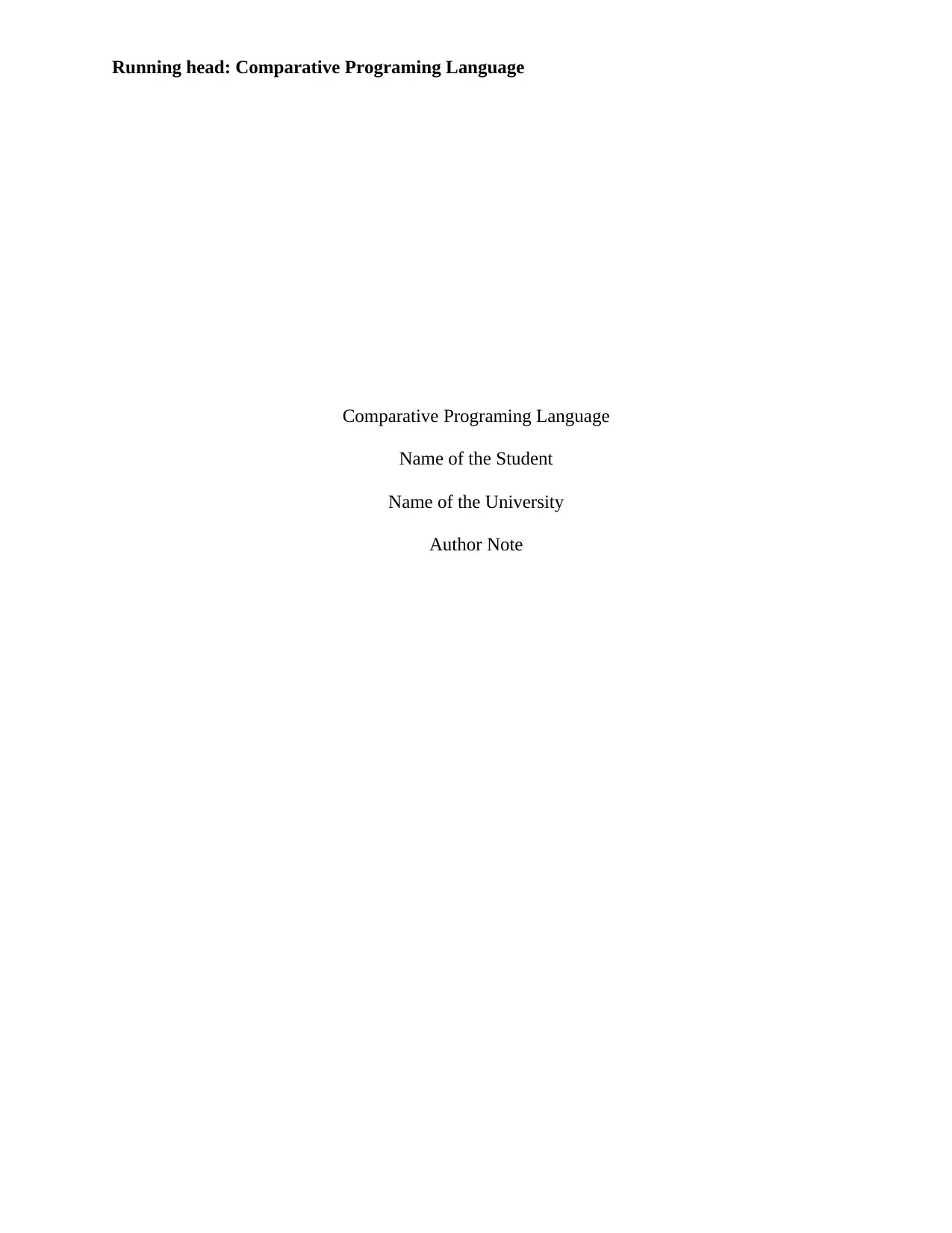
Running head: Comparative Programing Language
Comparative Programing Language
Name of the Student
Name of the University
Author Note
Comparative Programing Language
Name of the Student
Name of the University
Author Note
Paraphrase This Document
Need a fresh take? Get an instant paraphrase of this document with our AI Paraphraser
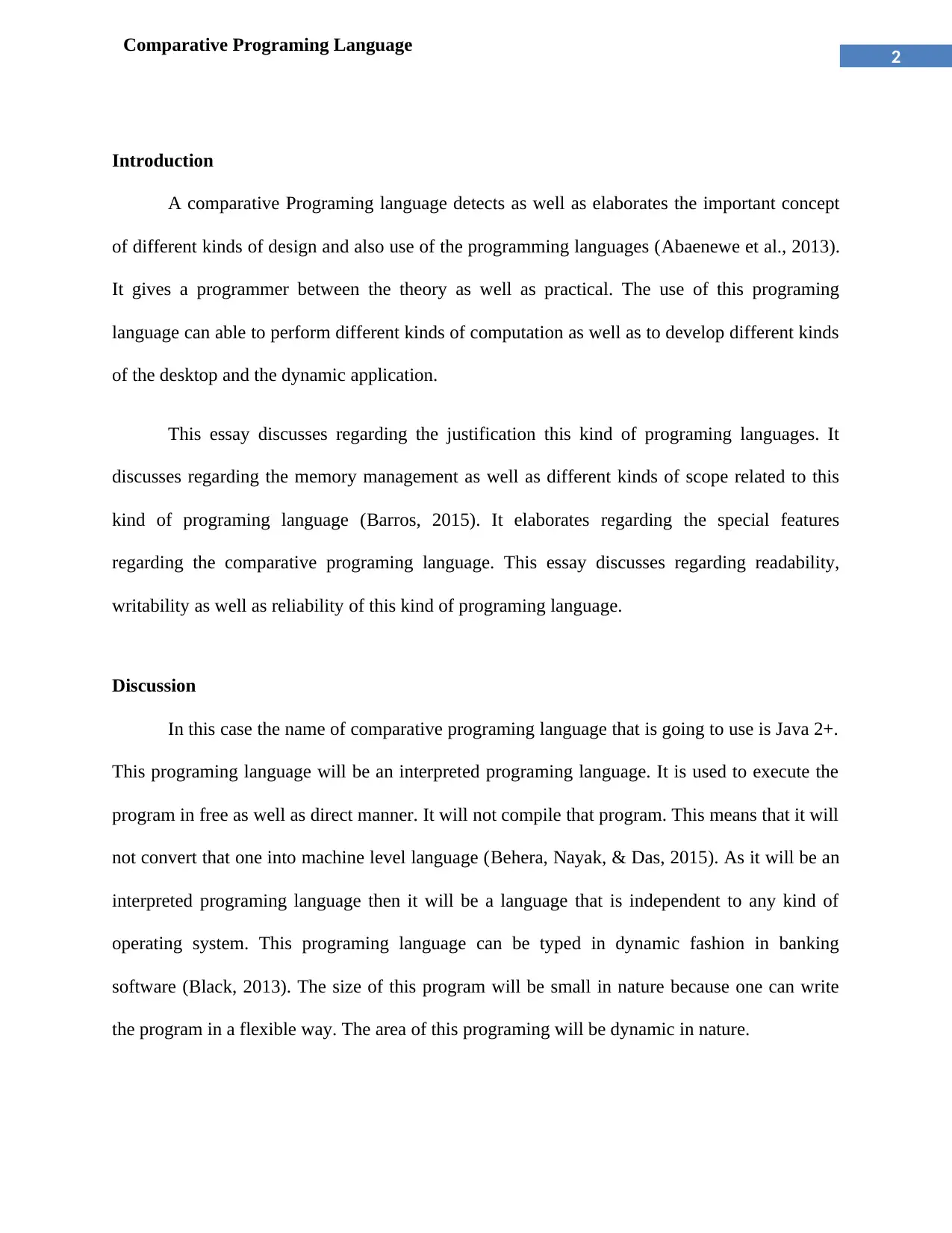
2
Comparative Programing Language
Introduction
A comparative Programing language detects as well as elaborates the important concept
of different kinds of design and also use of the programming languages (Abaenewe et al., 2013).
It gives a programmer between the theory as well as practical. The use of this programing
language can able to perform different kinds of computation as well as to develop different kinds
of the desktop and the dynamic application.
This essay discusses regarding the justification this kind of programing languages. It
discusses regarding the memory management as well as different kinds of scope related to this
kind of programing language (Barros, 2015). It elaborates regarding the special features
regarding the comparative programing language. This essay discusses regarding readability,
writability as well as reliability of this kind of programing language.
Discussion
In this case the name of comparative programing language that is going to use is Java 2+.
This programing language will be an interpreted programing language. It is used to execute the
program in free as well as direct manner. It will not compile that program. This means that it will
not convert that one into machine level language (Behera, Nayak, & Das, 2015). As it will be an
interpreted programing language then it will be a language that is independent to any kind of
operating system. This programing language can be typed in dynamic fashion in banking
software (Black, 2013). The size of this program will be small in nature because one can write
the program in a flexible way. The area of this programing will be dynamic in nature.
Comparative Programing Language
Introduction
A comparative Programing language detects as well as elaborates the important concept
of different kinds of design and also use of the programming languages (Abaenewe et al., 2013).
It gives a programmer between the theory as well as practical. The use of this programing
language can able to perform different kinds of computation as well as to develop different kinds
of the desktop and the dynamic application.
This essay discusses regarding the justification this kind of programing languages. It
discusses regarding the memory management as well as different kinds of scope related to this
kind of programing language (Barros, 2015). It elaborates regarding the special features
regarding the comparative programing language. This essay discusses regarding readability,
writability as well as reliability of this kind of programing language.
Discussion
In this case the name of comparative programing language that is going to use is Java 2+.
This programing language will be an interpreted programing language. It is used to execute the
program in free as well as direct manner. It will not compile that program. This means that it will
not convert that one into machine level language (Behera, Nayak, & Das, 2015). As it will be an
interpreted programing language then it will be a language that is independent to any kind of
operating system. This programing language can be typed in dynamic fashion in banking
software (Black, 2013). The size of this program will be small in nature because one can write
the program in a flexible way. The area of this programing will be dynamic in nature.
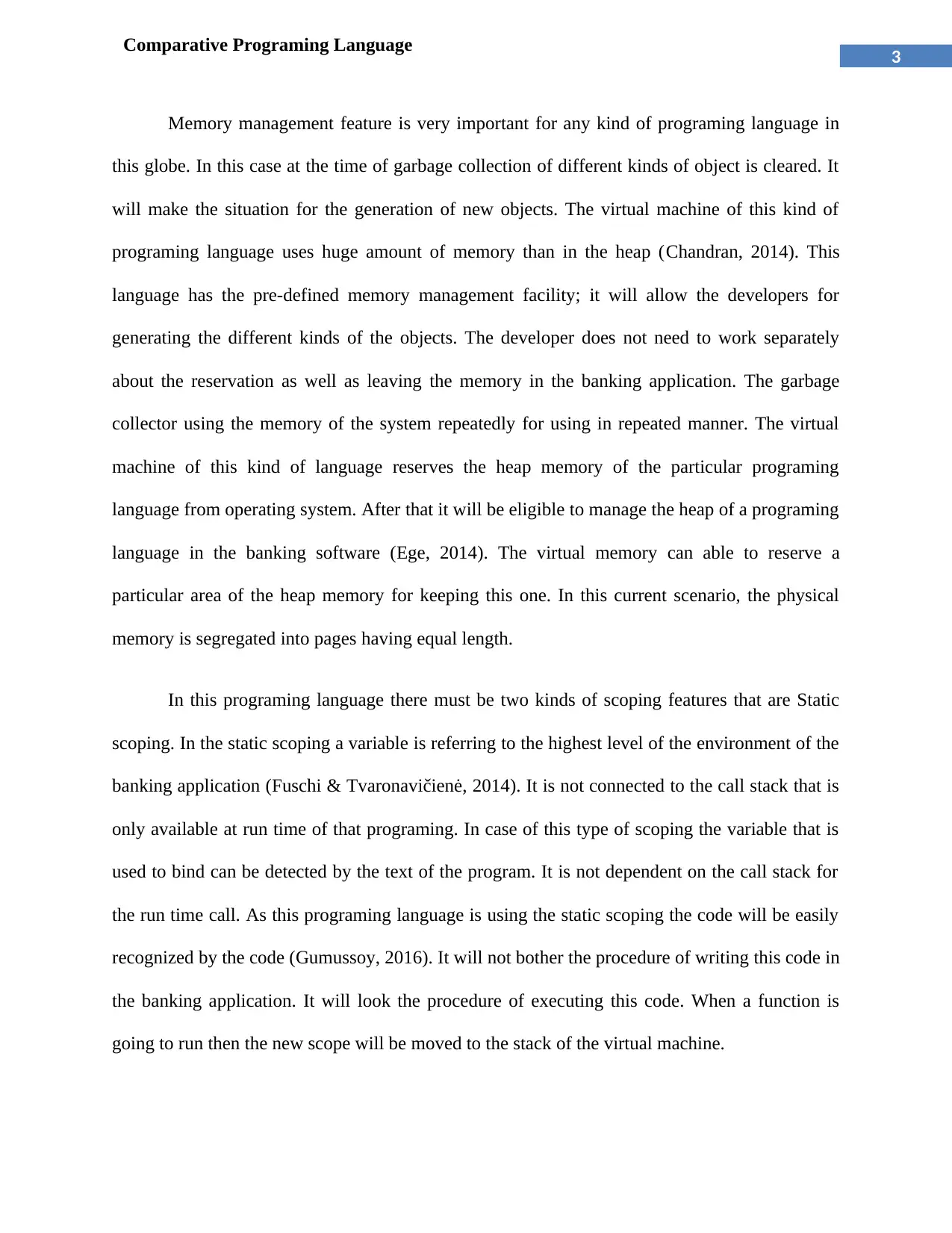
3
Comparative Programing Language
Memory management feature is very important for any kind of programing language in
this globe. In this case at the time of garbage collection of different kinds of object is cleared. It
will make the situation for the generation of new objects. The virtual machine of this kind of
programing language uses huge amount of memory than in the heap (Chandran, 2014). This
language has the pre-defined memory management facility; it will allow the developers for
generating the different kinds of the objects. The developer does not need to work separately
about the reservation as well as leaving the memory in the banking application. The garbage
collector using the memory of the system repeatedly for using in repeated manner. The virtual
machine of this kind of language reserves the heap memory of the particular programing
language from operating system. After that it will be eligible to manage the heap of a programing
language in the banking software (Ege, 2014). The virtual memory can able to reserve a
particular area of the heap memory for keeping this one. In this current scenario, the physical
memory is segregated into pages having equal length.
In this programing language there must be two kinds of scoping features that are Static
scoping. In the static scoping a variable is referring to the highest level of the environment of the
banking application (Fuschi & Tvaronavičienė, 2014). It is not connected to the call stack that is
only available at run time of that programing. In case of this type of scoping the variable that is
used to bind can be detected by the text of the program. It is not dependent on the call stack for
the run time call. As this programing language is using the static scoping the code will be easily
recognized by the code (Gumussoy, 2016). It will not bother the procedure of writing this code in
the banking application. It will look the procedure of executing this code. When a function is
going to run then the new scope will be moved to the stack of the virtual machine.
Comparative Programing Language
Memory management feature is very important for any kind of programing language in
this globe. In this case at the time of garbage collection of different kinds of object is cleared. It
will make the situation for the generation of new objects. The virtual machine of this kind of
programing language uses huge amount of memory than in the heap (Chandran, 2014). This
language has the pre-defined memory management facility; it will allow the developers for
generating the different kinds of the objects. The developer does not need to work separately
about the reservation as well as leaving the memory in the banking application. The garbage
collector using the memory of the system repeatedly for using in repeated manner. The virtual
machine of this kind of language reserves the heap memory of the particular programing
language from operating system. After that it will be eligible to manage the heap of a programing
language in the banking software (Ege, 2014). The virtual memory can able to reserve a
particular area of the heap memory for keeping this one. In this current scenario, the physical
memory is segregated into pages having equal length.
In this programing language there must be two kinds of scoping features that are Static
scoping. In the static scoping a variable is referring to the highest level of the environment of the
banking application (Fuschi & Tvaronavičienė, 2014). It is not connected to the call stack that is
only available at run time of that programing. In case of this type of scoping the variable that is
used to bind can be detected by the text of the program. It is not dependent on the call stack for
the run time call. As this programing language is using the static scoping the code will be easily
recognized by the code (Gumussoy, 2016). It will not bother the procedure of writing this code in
the banking application. It will look the procedure of executing this code. When a function is
going to run then the new scope will be moved to the stack of the virtual machine.
⊘ This is a preview!⊘
Do you want full access?
Subscribe today to unlock all pages.

Trusted by 1+ million students worldwide
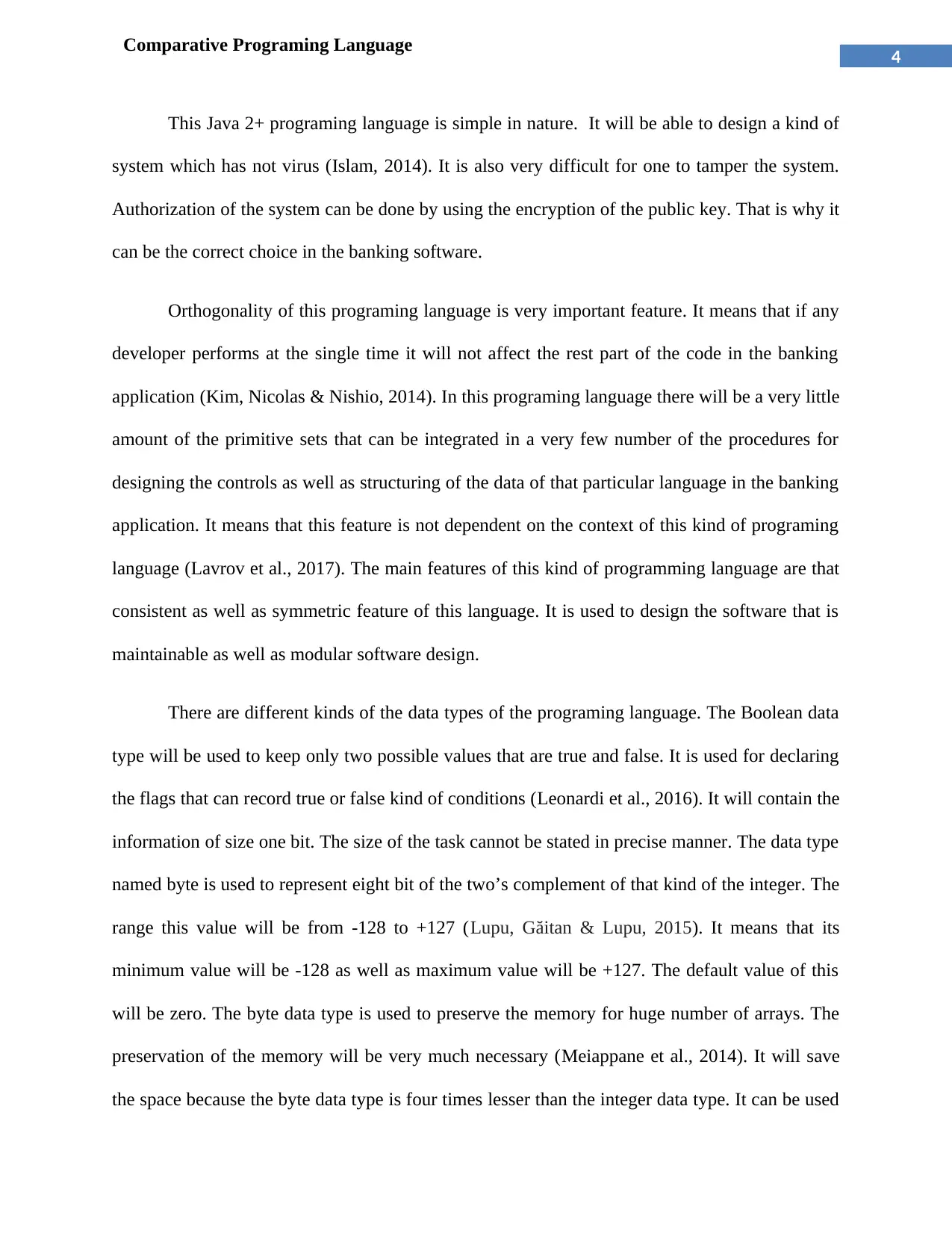
4
Comparative Programing Language
This Java 2+ programing language is simple in nature. It will be able to design a kind of
system which has not virus (Islam, 2014). It is also very difficult for one to tamper the system.
Authorization of the system can be done by using the encryption of the public key. That is why it
can be the correct choice in the banking software.
Orthogonality of this programing language is very important feature. It means that if any
developer performs at the single time it will not affect the rest part of the code in the banking
application (Kim, Nicolas & Nishio, 2014). In this programing language there will be a very little
amount of the primitive sets that can be integrated in a very few number of the procedures for
designing the controls as well as structuring of the data of that particular language in the banking
application. It means that this feature is not dependent on the context of this kind of programing
language (Lavrov et al., 2017). The main features of this kind of programming language are that
consistent as well as symmetric feature of this language. It is used to design the software that is
maintainable as well as modular software design.
There are different kinds of the data types of the programing language. The Boolean data
type will be used to keep only two possible values that are true and false. It is used for declaring
the flags that can record true or false kind of conditions (Leonardi et al., 2016). It will contain the
information of size one bit. The size of the task cannot be stated in precise manner. The data type
named byte is used to represent eight bit of the two’s complement of that kind of the integer. The
range this value will be from -128 to +127 (Lupu, Găitan & Lupu, 2015). It means that its
minimum value will be -128 as well as maximum value will be +127. The default value of this
will be zero. The byte data type is used to preserve the memory for huge number of arrays. The
preservation of the memory will be very much necessary (Meiappane et al., 2014). It will save
the space because the byte data type is four times lesser than the integer data type. It can be used
Comparative Programing Language
This Java 2+ programing language is simple in nature. It will be able to design a kind of
system which has not virus (Islam, 2014). It is also very difficult for one to tamper the system.
Authorization of the system can be done by using the encryption of the public key. That is why it
can be the correct choice in the banking software.
Orthogonality of this programing language is very important feature. It means that if any
developer performs at the single time it will not affect the rest part of the code in the banking
application (Kim, Nicolas & Nishio, 2014). In this programing language there will be a very little
amount of the primitive sets that can be integrated in a very few number of the procedures for
designing the controls as well as structuring of the data of that particular language in the banking
application. It means that this feature is not dependent on the context of this kind of programing
language (Lavrov et al., 2017). The main features of this kind of programming language are that
consistent as well as symmetric feature of this language. It is used to design the software that is
maintainable as well as modular software design.
There are different kinds of the data types of the programing language. The Boolean data
type will be used to keep only two possible values that are true and false. It is used for declaring
the flags that can record true or false kind of conditions (Leonardi et al., 2016). It will contain the
information of size one bit. The size of the task cannot be stated in precise manner. The data type
named byte is used to represent eight bit of the two’s complement of that kind of the integer. The
range this value will be from -128 to +127 (Lupu, Găitan & Lupu, 2015). It means that its
minimum value will be -128 as well as maximum value will be +127. The default value of this
will be zero. The byte data type is used to preserve the memory for huge number of arrays. The
preservation of the memory will be very much necessary (Meiappane et al., 2014). It will save
the space because the byte data type is four times lesser than the integer data type. It can be used
Paraphrase This Document
Need a fresh take? Get an instant paraphrase of this document with our AI Paraphraser
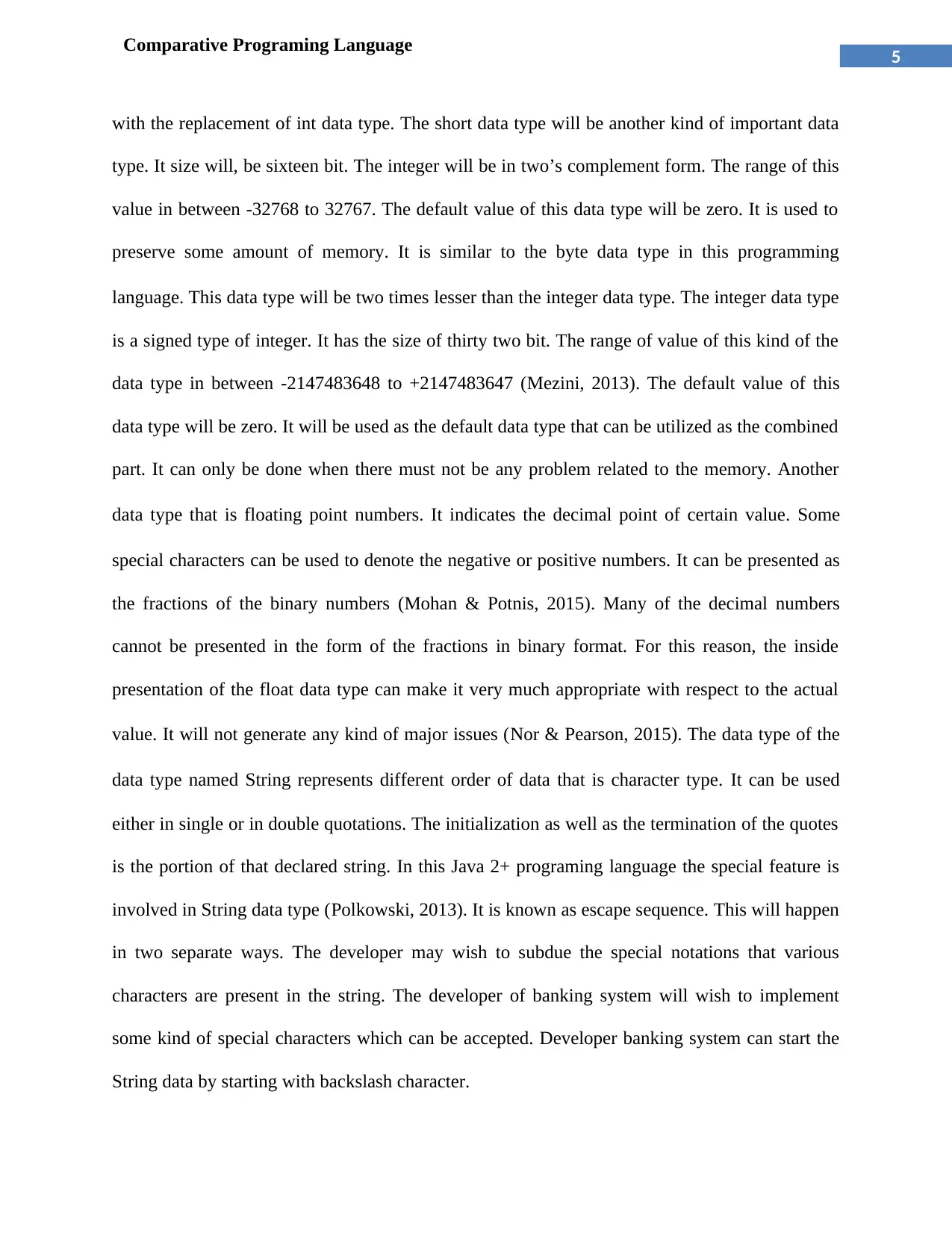
5
Comparative Programing Language
with the replacement of int data type. The short data type will be another kind of important data
type. It size will, be sixteen bit. The integer will be in two’s complement form. The range of this
value in between -32768 to 32767. The default value of this data type will be zero. It is used to
preserve some amount of memory. It is similar to the byte data type in this programming
language. This data type will be two times lesser than the integer data type. The integer data type
is a signed type of integer. It has the size of thirty two bit. The range of value of this kind of the
data type in between -2147483648 to +2147483647 (Mezini, 2013). The default value of this
data type will be zero. It will be used as the default data type that can be utilized as the combined
part. It can only be done when there must not be any problem related to the memory. Another
data type that is floating point numbers. It indicates the decimal point of certain value. Some
special characters can be used to denote the negative or positive numbers. It can be presented as
the fractions of the binary numbers (Mohan & Potnis, 2015). Many of the decimal numbers
cannot be presented in the form of the fractions in binary format. For this reason, the inside
presentation of the float data type can make it very much appropriate with respect to the actual
value. It will not generate any kind of major issues (Nor & Pearson, 2015). The data type of the
data type named String represents different order of data that is character type. It can be used
either in single or in double quotations. The initialization as well as the termination of the quotes
is the portion of that declared string. In this Java 2+ programing language the special feature is
involved in String data type (Polkowski, 2013). It is known as escape sequence. This will happen
in two separate ways. The developer may wish to subdue the special notations that various
characters are present in the string. The developer of banking system will wish to implement
some kind of special characters which can be accepted. Developer banking system can start the
String data by starting with backslash character.
Comparative Programing Language
with the replacement of int data type. The short data type will be another kind of important data
type. It size will, be sixteen bit. The integer will be in two’s complement form. The range of this
value in between -32768 to 32767. The default value of this data type will be zero. It is used to
preserve some amount of memory. It is similar to the byte data type in this programming
language. This data type will be two times lesser than the integer data type. The integer data type
is a signed type of integer. It has the size of thirty two bit. The range of value of this kind of the
data type in between -2147483648 to +2147483647 (Mezini, 2013). The default value of this
data type will be zero. It will be used as the default data type that can be utilized as the combined
part. It can only be done when there must not be any problem related to the memory. Another
data type that is floating point numbers. It indicates the decimal point of certain value. Some
special characters can be used to denote the negative or positive numbers. It can be presented as
the fractions of the binary numbers (Mohan & Potnis, 2015). Many of the decimal numbers
cannot be presented in the form of the fractions in binary format. For this reason, the inside
presentation of the float data type can make it very much appropriate with respect to the actual
value. It will not generate any kind of major issues (Nor & Pearson, 2015). The data type of the
data type named String represents different order of data that is character type. It can be used
either in single or in double quotations. The initialization as well as the termination of the quotes
is the portion of that declared string. In this Java 2+ programing language the special feature is
involved in String data type (Polkowski, 2013). It is known as escape sequence. This will happen
in two separate ways. The developer may wish to subdue the special notations that various
characters are present in the string. The developer of banking system will wish to implement
some kind of special characters which can be accepted. Developer banking system can start the
String data by starting with backslash character.
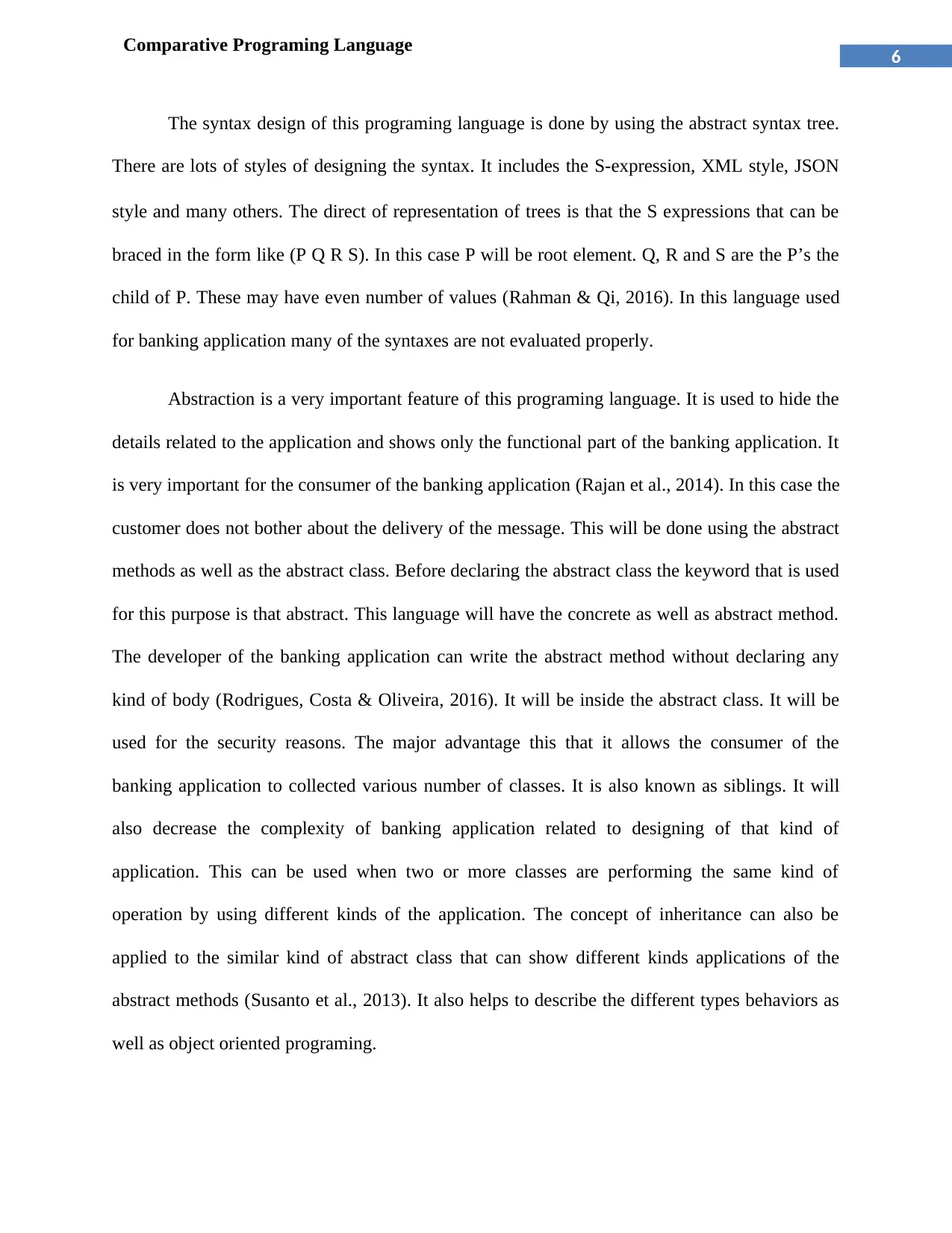
6
Comparative Programing Language
The syntax design of this programing language is done by using the abstract syntax tree.
There are lots of styles of designing the syntax. It includes the S-expression, XML style, JSON
style and many others. The direct of representation of trees is that the S expressions that can be
braced in the form like (P Q R S). In this case P will be root element. Q, R and S are the P’s the
child of P. These may have even number of values (Rahman & Qi, 2016). In this language used
for banking application many of the syntaxes are not evaluated properly.
Abstraction is a very important feature of this programing language. It is used to hide the
details related to the application and shows only the functional part of the banking application. It
is very important for the consumer of the banking application (Rajan et al., 2014). In this case the
customer does not bother about the delivery of the message. This will be done using the abstract
methods as well as the abstract class. Before declaring the abstract class the keyword that is used
for this purpose is that abstract. This language will have the concrete as well as abstract method.
The developer of the banking application can write the abstract method without declaring any
kind of body (Rodrigues, Costa & Oliveira, 2016). It will be inside the abstract class. It will be
used for the security reasons. The major advantage this that it allows the consumer of the
banking application to collected various number of classes. It is also known as siblings. It will
also decrease the complexity of banking application related to designing of that kind of
application. This can be used when two or more classes are performing the same kind of
operation by using different kinds of the application. The concept of inheritance can also be
applied to the similar kind of abstract class that can show different kinds applications of the
abstract methods (Susanto et al., 2013). It also helps to describe the different types behaviors as
well as object oriented programing.
Comparative Programing Language
The syntax design of this programing language is done by using the abstract syntax tree.
There are lots of styles of designing the syntax. It includes the S-expression, XML style, JSON
style and many others. The direct of representation of trees is that the S expressions that can be
braced in the form like (P Q R S). In this case P will be root element. Q, R and S are the P’s the
child of P. These may have even number of values (Rahman & Qi, 2016). In this language used
for banking application many of the syntaxes are not evaluated properly.
Abstraction is a very important feature of this programing language. It is used to hide the
details related to the application and shows only the functional part of the banking application. It
is very important for the consumer of the banking application (Rajan et al., 2014). In this case the
customer does not bother about the delivery of the message. This will be done using the abstract
methods as well as the abstract class. Before declaring the abstract class the keyword that is used
for this purpose is that abstract. This language will have the concrete as well as abstract method.
The developer of the banking application can write the abstract method without declaring any
kind of body (Rodrigues, Costa & Oliveira, 2016). It will be inside the abstract class. It will be
used for the security reasons. The major advantage this that it allows the consumer of the
banking application to collected various number of classes. It is also known as siblings. It will
also decrease the complexity of banking application related to designing of that kind of
application. This can be used when two or more classes are performing the same kind of
operation by using different kinds of the application. The concept of inheritance can also be
applied to the similar kind of abstract class that can show different kinds applications of the
abstract methods (Susanto et al., 2013). It also helps to describe the different types behaviors as
well as object oriented programing.
⊘ This is a preview!⊘
Do you want full access?
Subscribe today to unlock all pages.

Trusted by 1+ million students worldwide
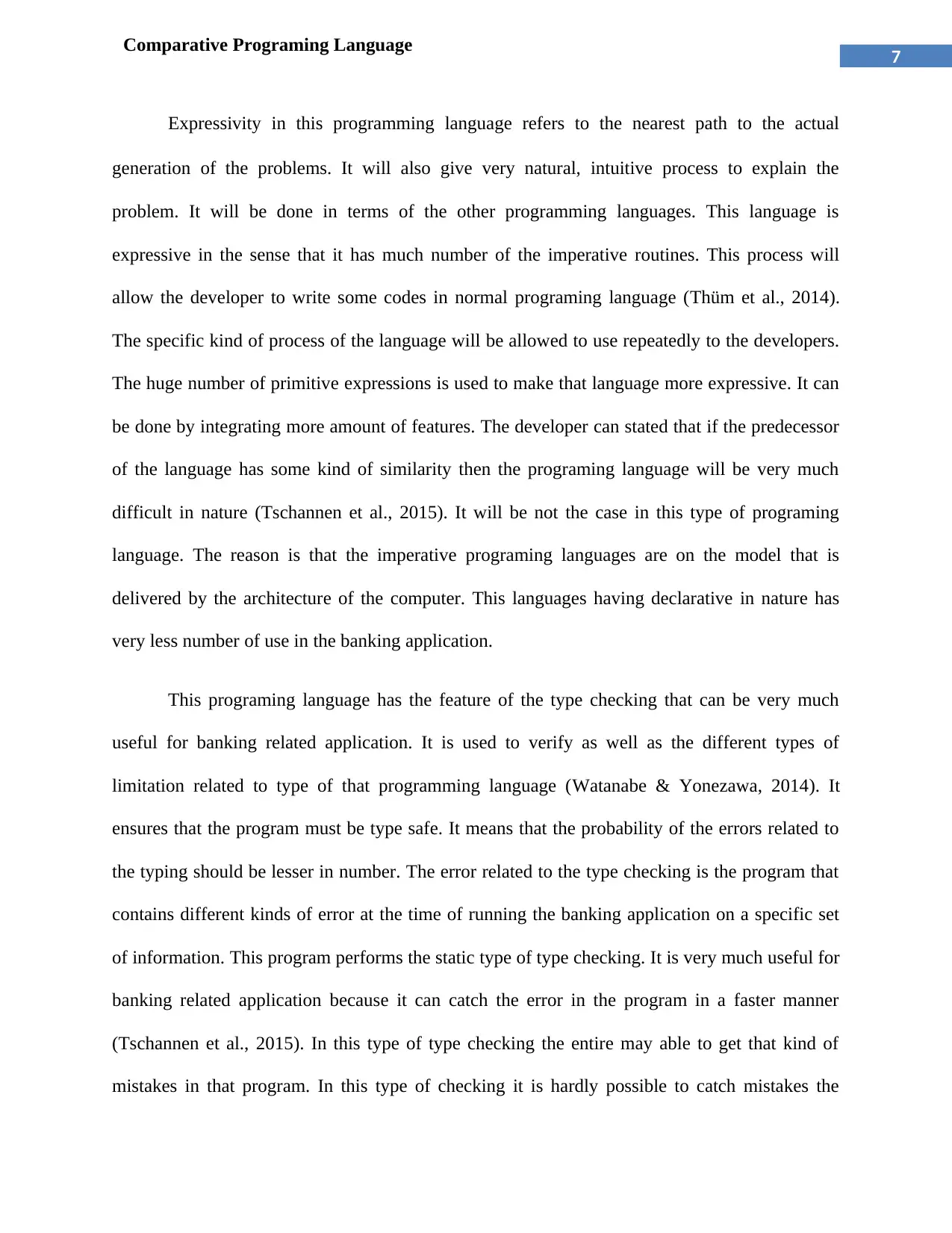
7
Comparative Programing Language
Expressivity in this programming language refers to the nearest path to the actual
generation of the problems. It will also give very natural, intuitive process to explain the
problem. It will be done in terms of the other programming languages. This language is
expressive in the sense that it has much number of the imperative routines. This process will
allow the developer to write some codes in normal programing language (Thüm et al., 2014).
The specific kind of process of the language will be allowed to use repeatedly to the developers.
The huge number of primitive expressions is used to make that language more expressive. It can
be done by integrating more amount of features. The developer can stated that if the predecessor
of the language has some kind of similarity then the programing language will be very much
difficult in nature (Tschannen et al., 2015). It will be not the case in this type of programing
language. The reason is that the imperative programing languages are on the model that is
delivered by the architecture of the computer. This languages having declarative in nature has
very less number of use in the banking application.
This programing language has the feature of the type checking that can be very much
useful for banking related application. It is used to verify as well as the different types of
limitation related to type of that programming language (Watanabe & Yonezawa, 2014). It
ensures that the program must be type safe. It means that the probability of the errors related to
the typing should be lesser in number. The error related to the type checking is the program that
contains different kinds of error at the time of running the banking application on a specific set
of information. This program performs the static type of type checking. It is very much useful for
banking related application because it can catch the error in the program in a faster manner
(Tschannen et al., 2015). In this type of type checking the entire may able to get that kind of
mistakes in that program. In this type of checking it is hardly possible to catch mistakes the
Comparative Programing Language
Expressivity in this programming language refers to the nearest path to the actual
generation of the problems. It will also give very natural, intuitive process to explain the
problem. It will be done in terms of the other programming languages. This language is
expressive in the sense that it has much number of the imperative routines. This process will
allow the developer to write some codes in normal programing language (Thüm et al., 2014).
The specific kind of process of the language will be allowed to use repeatedly to the developers.
The huge number of primitive expressions is used to make that language more expressive. It can
be done by integrating more amount of features. The developer can stated that if the predecessor
of the language has some kind of similarity then the programing language will be very much
difficult in nature (Tschannen et al., 2015). It will be not the case in this type of programing
language. The reason is that the imperative programing languages are on the model that is
delivered by the architecture of the computer. This languages having declarative in nature has
very less number of use in the banking application.
This programing language has the feature of the type checking that can be very much
useful for banking related application. It is used to verify as well as the different types of
limitation related to type of that programming language (Watanabe & Yonezawa, 2014). It
ensures that the program must be type safe. It means that the probability of the errors related to
the typing should be lesser in number. The error related to the type checking is the program that
contains different kinds of error at the time of running the banking application on a specific set
of information. This program performs the static type of type checking. It is very much useful for
banking related application because it can catch the error in the program in a faster manner
(Tschannen et al., 2015). In this type of type checking the entire may able to get that kind of
mistakes in that program. In this type of checking it is hardly possible to catch mistakes the
Paraphrase This Document
Need a fresh take? Get an instant paraphrase of this document with our AI Paraphraser
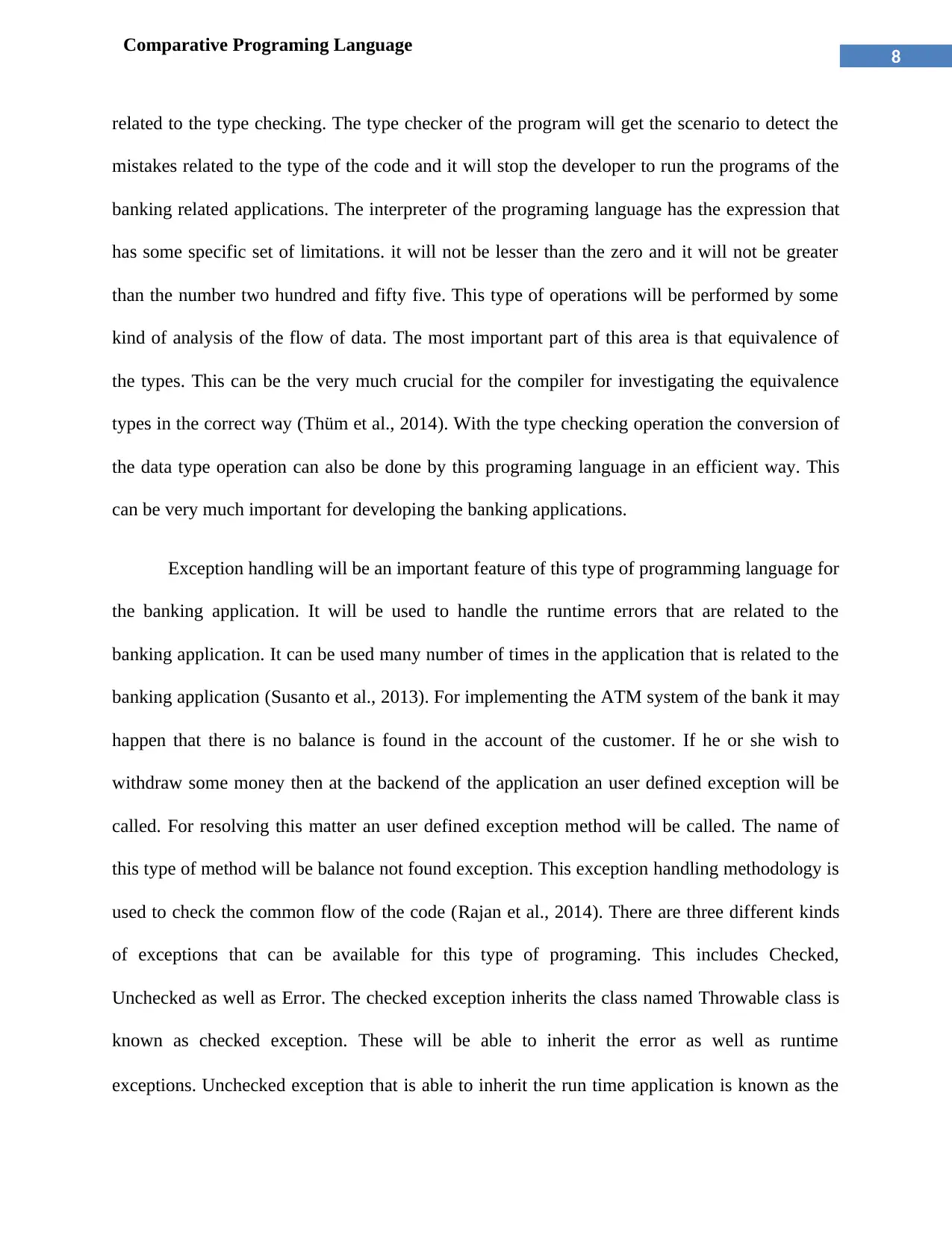
8
Comparative Programing Language
related to the type checking. The type checker of the program will get the scenario to detect the
mistakes related to the type of the code and it will stop the developer to run the programs of the
banking related applications. The interpreter of the programing language has the expression that
has some specific set of limitations. it will not be lesser than the zero and it will not be greater
than the number two hundred and fifty five. This type of operations will be performed by some
kind of analysis of the flow of data. The most important part of this area is that equivalence of
the types. This can be the very much crucial for the compiler for investigating the equivalence
types in the correct way (Thüm et al., 2014). With the type checking operation the conversion of
the data type operation can also be done by this programing language in an efficient way. This
can be very much important for developing the banking applications.
Exception handling will be an important feature of this type of programming language for
the banking application. It will be used to handle the runtime errors that are related to the
banking application. It can be used many number of times in the application that is related to the
banking application (Susanto et al., 2013). For implementing the ATM system of the bank it may
happen that there is no balance is found in the account of the customer. If he or she wish to
withdraw some money then at the backend of the application an user defined exception will be
called. For resolving this matter an user defined exception method will be called. The name of
this type of method will be balance not found exception. This exception handling methodology is
used to check the common flow of the code (Rajan et al., 2014). There are three different kinds
of exceptions that can be available for this type of programing. This includes Checked,
Unchecked as well as Error. The checked exception inherits the class named Throwable class is
known as checked exception. These will be able to inherit the error as well as runtime
exceptions. Unchecked exception that is able to inherit the run time application is known as the
Comparative Programing Language
related to the type checking. The type checker of the program will get the scenario to detect the
mistakes related to the type of the code and it will stop the developer to run the programs of the
banking related applications. The interpreter of the programing language has the expression that
has some specific set of limitations. it will not be lesser than the zero and it will not be greater
than the number two hundred and fifty five. This type of operations will be performed by some
kind of analysis of the flow of data. The most important part of this area is that equivalence of
the types. This can be the very much crucial for the compiler for investigating the equivalence
types in the correct way (Thüm et al., 2014). With the type checking operation the conversion of
the data type operation can also be done by this programing language in an efficient way. This
can be very much important for developing the banking applications.
Exception handling will be an important feature of this type of programming language for
the banking application. It will be used to handle the runtime errors that are related to the
banking application. It can be used many number of times in the application that is related to the
banking application (Susanto et al., 2013). For implementing the ATM system of the bank it may
happen that there is no balance is found in the account of the customer. If he or she wish to
withdraw some money then at the backend of the application an user defined exception will be
called. For resolving this matter an user defined exception method will be called. The name of
this type of method will be balance not found exception. This exception handling methodology is
used to check the common flow of the code (Rajan et al., 2014). There are three different kinds
of exceptions that can be available for this type of programing. This includes Checked,
Unchecked as well as Error. The checked exception inherits the class named Throwable class is
known as checked exception. These will be able to inherit the error as well as runtime
exceptions. Unchecked exception that is able to inherit the run time application is known as the
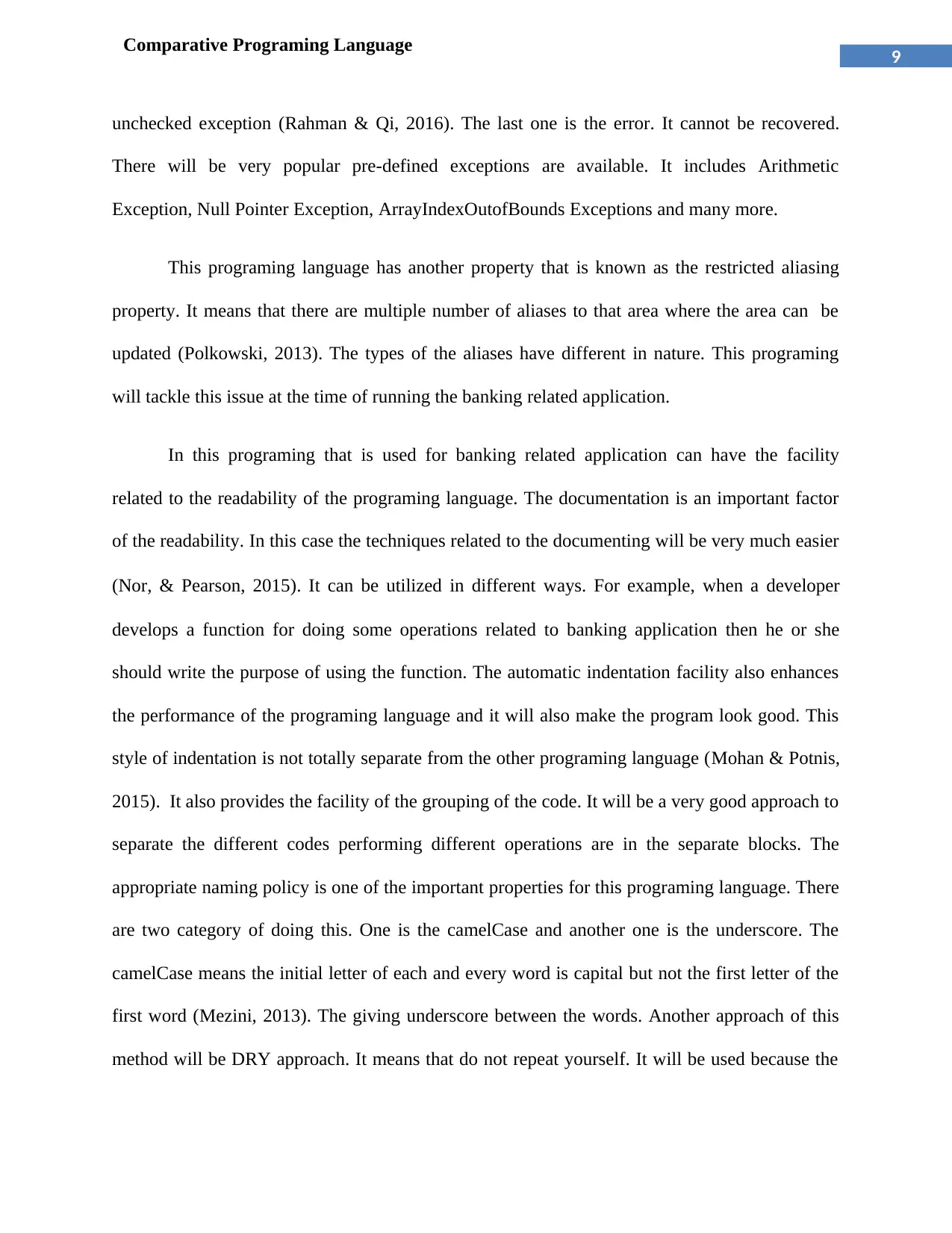
9
Comparative Programing Language
unchecked exception (Rahman & Qi, 2016). The last one is the error. It cannot be recovered.
There will be very popular pre-defined exceptions are available. It includes Arithmetic
Exception, Null Pointer Exception, ArrayIndexOutofBounds Exceptions and many more.
This programing language has another property that is known as the restricted aliasing
property. It means that there are multiple number of aliases to that area where the area can be
updated (Polkowski, 2013). The types of the aliases have different in nature. This programing
will tackle this issue at the time of running the banking related application.
In this programing that is used for banking related application can have the facility
related to the readability of the programing language. The documentation is an important factor
of the readability. In this case the techniques related to the documenting will be very much easier
(Nor, & Pearson, 2015). It can be utilized in different ways. For example, when a developer
develops a function for doing some operations related to banking application then he or she
should write the purpose of using the function. The automatic indentation facility also enhances
the performance of the programing language and it will also make the program look good. This
style of indentation is not totally separate from the other programing language (Mohan & Potnis,
2015). It also provides the facility of the grouping of the code. It will be a very good approach to
separate the different codes performing different operations are in the separate blocks. The
appropriate naming policy is one of the important properties for this programing language. There
are two category of doing this. One is the camelCase and another one is the underscore. The
camelCase means the initial letter of each and every word is capital but not the first letter of the
first word (Mezini, 2013). The giving underscore between the words. Another approach of this
method will be DRY approach. It means that do not repeat yourself. It will be used because the
Comparative Programing Language
unchecked exception (Rahman & Qi, 2016). The last one is the error. It cannot be recovered.
There will be very popular pre-defined exceptions are available. It includes Arithmetic
Exception, Null Pointer Exception, ArrayIndexOutofBounds Exceptions and many more.
This programing language has another property that is known as the restricted aliasing
property. It means that there are multiple number of aliases to that area where the area can be
updated (Polkowski, 2013). The types of the aliases have different in nature. This programing
will tackle this issue at the time of running the banking related application.
In this programing that is used for banking related application can have the facility
related to the readability of the programing language. The documentation is an important factor
of the readability. In this case the techniques related to the documenting will be very much easier
(Nor, & Pearson, 2015). It can be utilized in different ways. For example, when a developer
develops a function for doing some operations related to banking application then he or she
should write the purpose of using the function. The automatic indentation facility also enhances
the performance of the programing language and it will also make the program look good. This
style of indentation is not totally separate from the other programing language (Mohan & Potnis,
2015). It also provides the facility of the grouping of the code. It will be a very good approach to
separate the different codes performing different operations are in the separate blocks. The
appropriate naming policy is one of the important properties for this programing language. There
are two category of doing this. One is the camelCase and another one is the underscore. The
camelCase means the initial letter of each and every word is capital but not the first letter of the
first word (Mezini, 2013). The giving underscore between the words. Another approach of this
method will be DRY approach. It means that do not repeat yourself. It will be used because the
⊘ This is a preview!⊘
Do you want full access?
Subscribe today to unlock all pages.

Trusted by 1+ million students worldwide
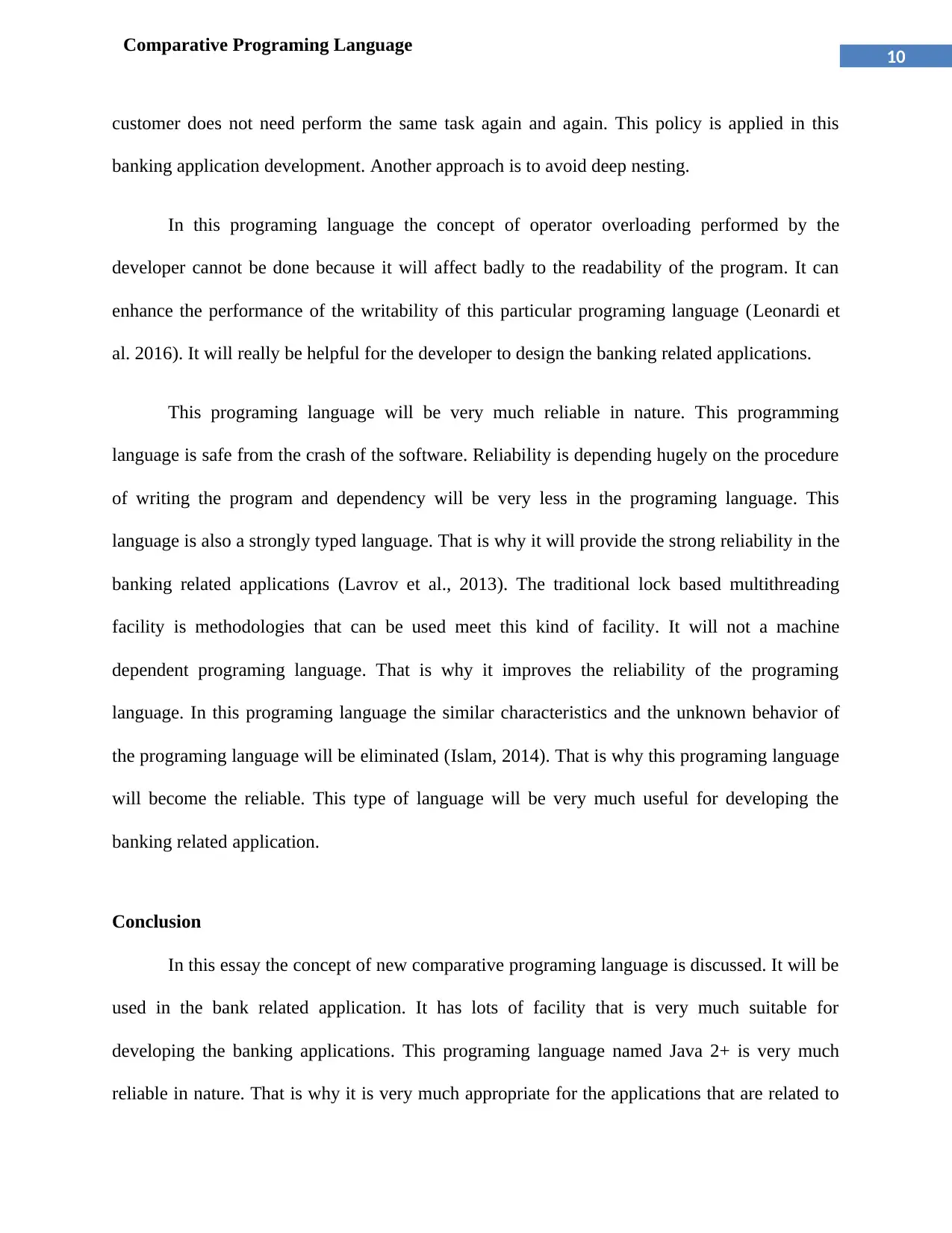
10
Comparative Programing Language
customer does not need perform the same task again and again. This policy is applied in this
banking application development. Another approach is to avoid deep nesting.
In this programing language the concept of operator overloading performed by the
developer cannot be done because it will affect badly to the readability of the program. It can
enhance the performance of the writability of this particular programing language (Leonardi et
al. 2016). It will really be helpful for the developer to design the banking related applications.
This programing language will be very much reliable in nature. This programming
language is safe from the crash of the software. Reliability is depending hugely on the procedure
of writing the program and dependency will be very less in the programing language. This
language is also a strongly typed language. That is why it will provide the strong reliability in the
banking related applications (Lavrov et al., 2013). The traditional lock based multithreading
facility is methodologies that can be used meet this kind of facility. It will not a machine
dependent programing language. That is why it improves the reliability of the programing
language. In this programing language the similar characteristics and the unknown behavior of
the programing language will be eliminated (Islam, 2014). That is why this programing language
will become the reliable. This type of language will be very much useful for developing the
banking related application.
Conclusion
In this essay the concept of new comparative programing language is discussed. It will be
used in the bank related application. It has lots of facility that is very much suitable for
developing the banking applications. This programing language named Java 2+ is very much
reliable in nature. That is why it is very much appropriate for the applications that are related to
Comparative Programing Language
customer does not need perform the same task again and again. This policy is applied in this
banking application development. Another approach is to avoid deep nesting.
In this programing language the concept of operator overloading performed by the
developer cannot be done because it will affect badly to the readability of the program. It can
enhance the performance of the writability of this particular programing language (Leonardi et
al. 2016). It will really be helpful for the developer to design the banking related applications.
This programing language will be very much reliable in nature. This programming
language is safe from the crash of the software. Reliability is depending hugely on the procedure
of writing the program and dependency will be very less in the programing language. This
language is also a strongly typed language. That is why it will provide the strong reliability in the
banking related applications (Lavrov et al., 2013). The traditional lock based multithreading
facility is methodologies that can be used meet this kind of facility. It will not a machine
dependent programing language. That is why it improves the reliability of the programing
language. In this programing language the similar characteristics and the unknown behavior of
the programing language will be eliminated (Islam, 2014). That is why this programing language
will become the reliable. This type of language will be very much useful for developing the
banking related application.
Conclusion
In this essay the concept of new comparative programing language is discussed. It will be
used in the bank related application. It has lots of facility that is very much suitable for
developing the banking applications. This programing language named Java 2+ is very much
reliable in nature. That is why it is very much appropriate for the applications that are related to
Paraphrase This Document
Need a fresh take? Get an instant paraphrase of this document with our AI Paraphraser
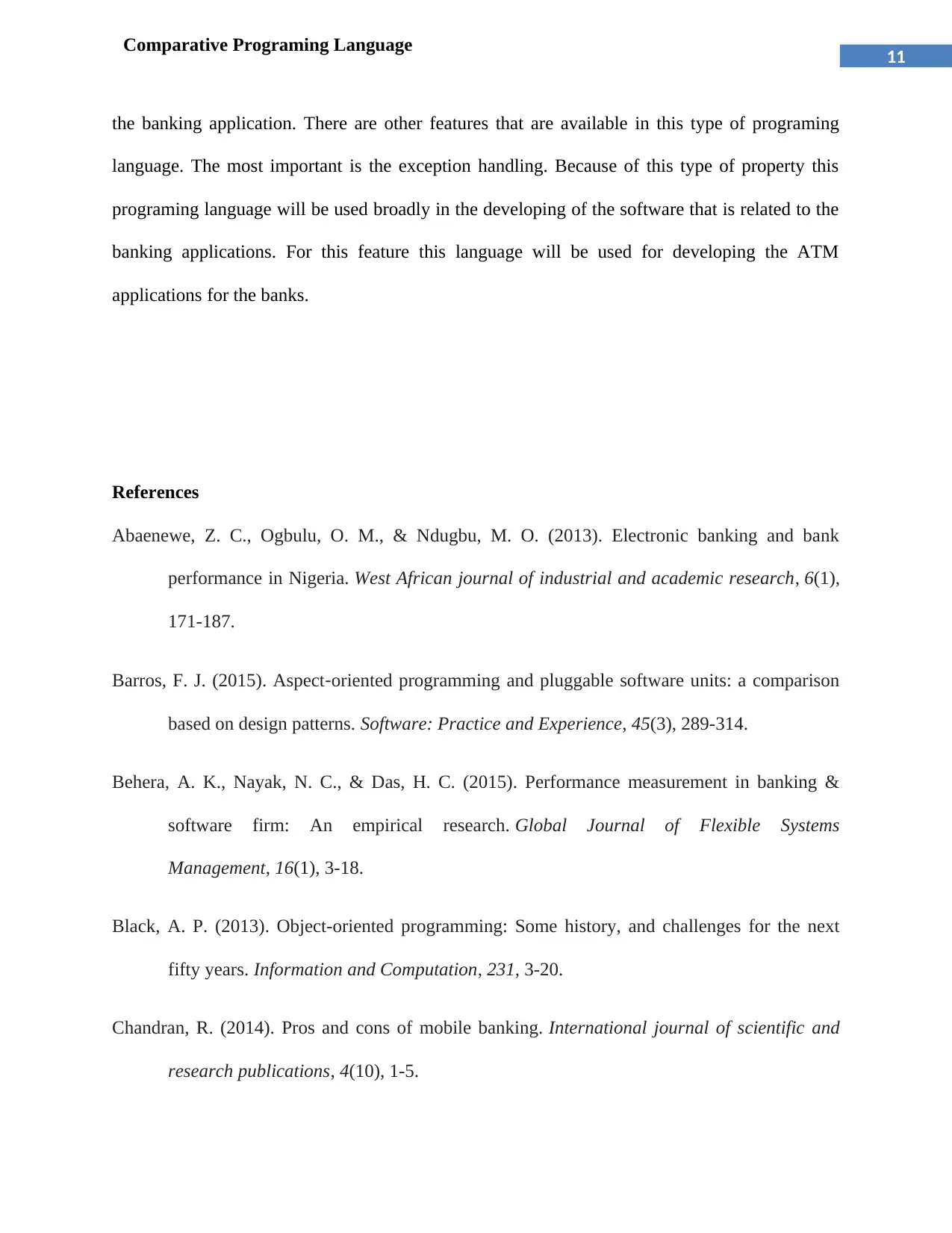
11
Comparative Programing Language
the banking application. There are other features that are available in this type of programing
language. The most important is the exception handling. Because of this type of property this
programing language will be used broadly in the developing of the software that is related to the
banking applications. For this feature this language will be used for developing the ATM
applications for the banks.
References
Abaenewe, Z. C., Ogbulu, O. M., & Ndugbu, M. O. (2013). Electronic banking and bank
performance in Nigeria. West African journal of industrial and academic research, 6(1),
171-187.
Barros, F. J. (2015). Aspect‐oriented programming and pluggable software units: a comparison
based on design patterns. Software: Practice and Experience, 45(3), 289-314.
Behera, A. K., Nayak, N. C., & Das, H. C. (2015). Performance measurement in banking &
software firm: An empirical research. Global Journal of Flexible Systems
Management, 16(1), 3-18.
Black, A. P. (2013). Object-oriented programming: Some history, and challenges for the next
fifty years. Information and Computation, 231, 3-20.
Chandran, R. (2014). Pros and cons of mobile banking. International journal of scientific and
research publications, 4(10), 1-5.
Comparative Programing Language
the banking application. There are other features that are available in this type of programing
language. The most important is the exception handling. Because of this type of property this
programing language will be used broadly in the developing of the software that is related to the
banking applications. For this feature this language will be used for developing the ATM
applications for the banks.
References
Abaenewe, Z. C., Ogbulu, O. M., & Ndugbu, M. O. (2013). Electronic banking and bank
performance in Nigeria. West African journal of industrial and academic research, 6(1),
171-187.
Barros, F. J. (2015). Aspect‐oriented programming and pluggable software units: a comparison
based on design patterns. Software: Practice and Experience, 45(3), 289-314.
Behera, A. K., Nayak, N. C., & Das, H. C. (2015). Performance measurement in banking &
software firm: An empirical research. Global Journal of Flexible Systems
Management, 16(1), 3-18.
Black, A. P. (2013). Object-oriented programming: Some history, and challenges for the next
fifty years. Information and Computation, 231, 3-20.
Chandran, R. (2014). Pros and cons of mobile banking. International journal of scientific and
research publications, 4(10), 1-5.
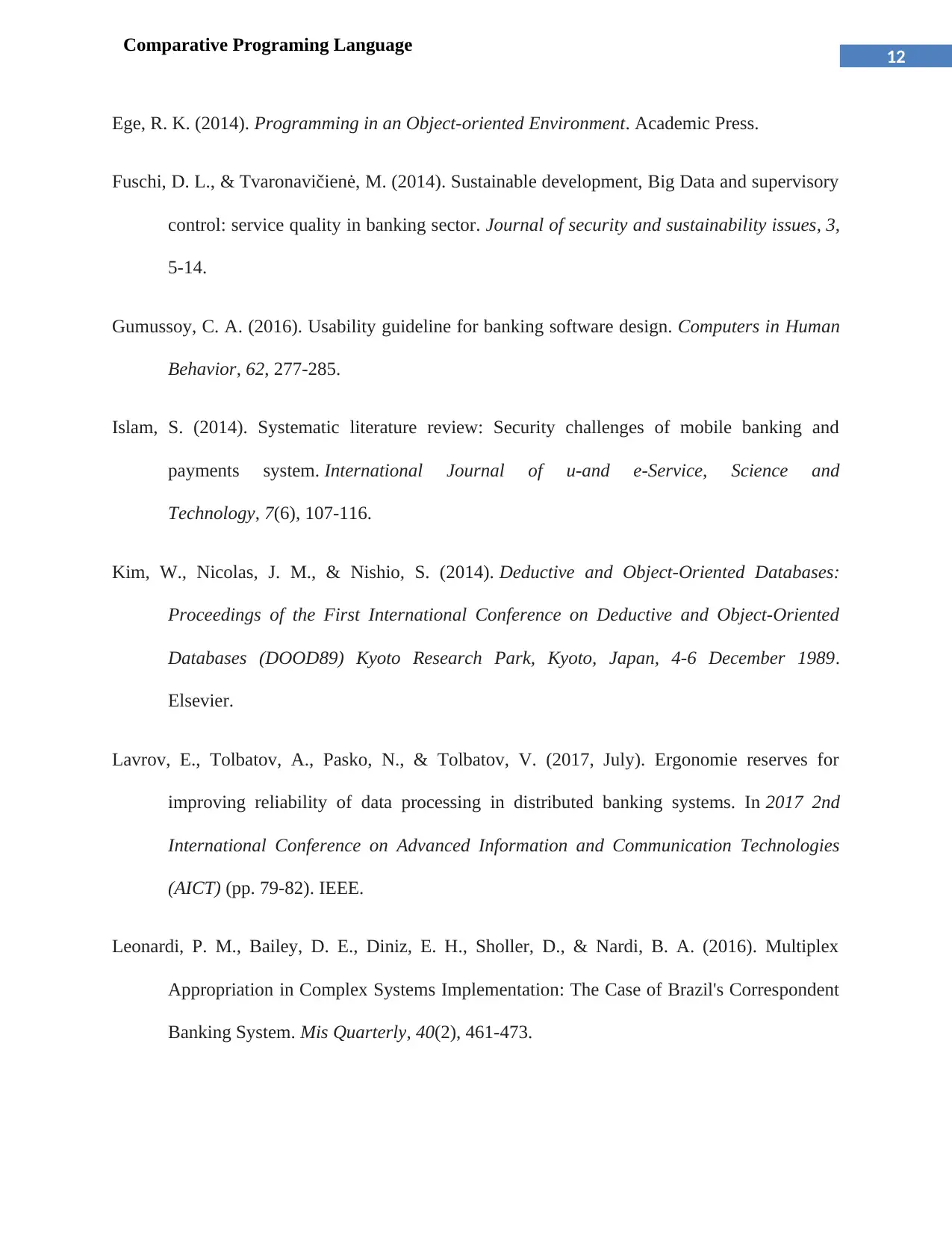
12
Comparative Programing Language
Ege, R. K. (2014). Programming in an Object-oriented Environment. Academic Press.
Fuschi, D. L., & Tvaronavičienė, M. (2014). Sustainable development, Big Data and supervisory
control: service quality in banking sector. Journal of security and sustainability issues, 3,
5-14.
Gumussoy, C. A. (2016). Usability guideline for banking software design. Computers in Human
Behavior, 62, 277-285.
Islam, S. (2014). Systematic literature review: Security challenges of mobile banking and
payments system. International Journal of u-and e-Service, Science and
Technology, 7(6), 107-116.
Kim, W., Nicolas, J. M., & Nishio, S. (2014). Deductive and Object-Oriented Databases:
Proceedings of the First International Conference on Deductive and Object-Oriented
Databases (DOOD89) Kyoto Research Park, Kyoto, Japan, 4-6 December 1989.
Elsevier.
Lavrov, E., Tolbatov, A., Pasko, N., & Tolbatov, V. (2017, July). Ergonomie reserves for
improving reliability of data processing in distributed banking systems. In 2017 2nd
International Conference on Advanced Information and Communication Technologies
(AICT) (pp. 79-82). IEEE.
Leonardi, P. M., Bailey, D. E., Diniz, E. H., Sholler, D., & Nardi, B. A. (2016). Multiplex
Appropriation in Complex Systems Implementation: The Case of Brazil's Correspondent
Banking System. Mis Quarterly, 40(2), 461-473.
Comparative Programing Language
Ege, R. K. (2014). Programming in an Object-oriented Environment. Academic Press.
Fuschi, D. L., & Tvaronavičienė, M. (2014). Sustainable development, Big Data and supervisory
control: service quality in banking sector. Journal of security and sustainability issues, 3,
5-14.
Gumussoy, C. A. (2016). Usability guideline for banking software design. Computers in Human
Behavior, 62, 277-285.
Islam, S. (2014). Systematic literature review: Security challenges of mobile banking and
payments system. International Journal of u-and e-Service, Science and
Technology, 7(6), 107-116.
Kim, W., Nicolas, J. M., & Nishio, S. (2014). Deductive and Object-Oriented Databases:
Proceedings of the First International Conference on Deductive and Object-Oriented
Databases (DOOD89) Kyoto Research Park, Kyoto, Japan, 4-6 December 1989.
Elsevier.
Lavrov, E., Tolbatov, A., Pasko, N., & Tolbatov, V. (2017, July). Ergonomie reserves for
improving reliability of data processing in distributed banking systems. In 2017 2nd
International Conference on Advanced Information and Communication Technologies
(AICT) (pp. 79-82). IEEE.
Leonardi, P. M., Bailey, D. E., Diniz, E. H., Sholler, D., & Nardi, B. A. (2016). Multiplex
Appropriation in Complex Systems Implementation: The Case of Brazil's Correspondent
Banking System. Mis Quarterly, 40(2), 461-473.
⊘ This is a preview!⊘
Do you want full access?
Subscribe today to unlock all pages.

Trusted by 1+ million students worldwide
1 out of 14
Related Documents
Your All-in-One AI-Powered Toolkit for Academic Success.
+13062052269
info@desklib.com
Available 24*7 on WhatsApp / Email
![[object Object]](/_next/static/media/star-bottom.7253800d.svg)
Unlock your academic potential
Copyright © 2020–2025 A2Z Services. All Rights Reserved. Developed and managed by ZUCOL.




